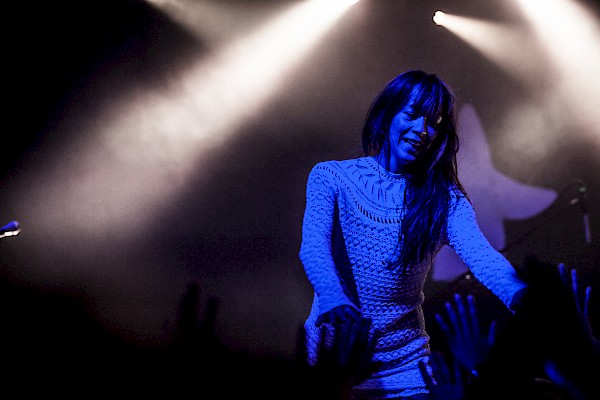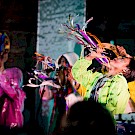Nostalgia can be a loaded word in the music world. Fondness for a band, song or album in connection to a time past can connect the listener to related memories pertaining to that moment, but only that moment. Memories are only memories as defined by our sensory experiences, and help us form our interpretations of them only after the fact. Some bands carry nostalgia as a badge of honor, and their music is able to transcend the trends and dominating sounds of the time. Others fall from grace, unable to keep up with the brilliance of their earlier work, or simply become too intent on fitting in with a new generation. But for every Weezer, and for every Blue Album, there is a Blonde Redhead that remains relevant without ever having to depart from the sound that they pioneered years ago.
Years ago in this case would be 1995, the year that Blonde Redhead released their debut self-titled album. The mid ‘90s were saturated with big labels pumping out overproduced pop albums, while hip-hop was just finding its footing as a viable means of making huge lumps of cash. As a result, the idea of an indie band was a bit of a novelty; however, Blonde Redhead quickly proved to be anything but a novelty.
Formed by lead singer Kazu Makino, Amedeo Pace, Simone Pace and ex-bassist Maki Takahashi, the band brought noise rock to the New York scene in a time when no definitive name had been given to the genre. It’s a term that you hear quite often now, but Blonde Redhead were, in a sense, pioneers of it, giving a hard edge to what had previously been tagged as shoegaze.
 Click to see more photos of Blonde Redhead by Sam Gehrke
Click to see more photos of Blonde Redhead by Sam Gehrke
Since then, the band have released eight more albums and remain just as relevant as they were in the mid ‘90s, interweaving into pop culture seamlessly with tracks appearing in everything from Pontiac ad spots to the cult classic animated series Rick and Morty. Despite their commercial success, they’ve never been a band to pander or sell out to soul-crushing corporate influence: A Blonde Redhead album is always an intimate listen, and the relatable lyrical content laced into every LP packs just as much emotion and depth as the soundscapes that propel it.
Since their formation, the band’s sound has evolved into a more precise, obsessively constructed amalgamation of every genre they’ve previously explored. Their latest album, Barragán, released in 2014, was a testament to this evolution. Although many critics regarded it as a confusing departure from their tried-and-true formula, I tend to disagree. Minimalistic does not always equal different, and despite many reviews stating that the album was a reinvention for the sake of reinventing, Barragán was a more nuanced, thoughtfully planned entry into the band’s discography. But really, what weight do critics hold in the overall scheme of things? As Jay-Z once famously stated: “Hov’ on that new shit, niggas like how come? Niggas want my old shit, buy my old albums.”
Blonde Redhead’s Barragán Tour stopped off in Portland last weekend on Saturday, September 19, transforming the Wonder Ballroom into a haunting opera of ethereal melodies, fuzzy riffs and equally (warm and) fuzzy memories. An eerie blue light filled the stage and an ominous clacking sound reverberated throughout the Wonder as the clock struck nine. One by one, Makino and the Pace brothers filed onto the stage and took their positions.
 Makino: elegant and mysterious—click to see an entire gallery of photos by Sam Gehrke
Makino: elegant and mysterious—click to see an entire gallery of photos by Sam Gehrke
The band eased into a slow, synth-heavy start to the set, Makino crooning in a fragile, broken-sounding voice that hushed the audience immediately. Awed reverence gave way to euphoric dancing as each song grew into a crescendo of abrasive jams balanced with an almost indescribable tone of delicacy. The Pace brothers steadily churned out song after song, anchor points to Makino’s otherworldly stage presence. Makino herself exuded an aura of mystery—hair draping elegantly over her face as she swayed back and forth across the stage. A symbiosis of crowd and performers began to occur. The audience began to move with Makino, mimicking every movement as she belted out a variety of tracks spanning the band’s career.
The show wrapped up with a solemn end as the group shifted gears, reverting back into a hypnotic pace similar to its beginning. Thunderous applause took the place of stunned silence almost immediately after Makino and the Pace brothers left the stage. Three minutes passed with the roar of clapping hands not wavering once. The bandmates appeared once again, meeting the encore with gusto and finishing the set with a resounding finale. Makino cried out her final verse, hung her head low and turned her face to the audience with a warm smile, traversing the edge of the stage and grasping the outstretched arms of the crowd.
 Makino grasping the crowd's outstretched arms—click to see an entire gallery of photos by Sam Gehrke
Makino grasping the crowd's outstretched arms—click to see an entire gallery of photos by Sam Gehrke
In talking with showgoers after the concert, there wasn’t a single person who didn’t mention the word nostalgia, accompanied with an enthusiasm as if they were hearing the band for the first time. And that’s the difference with Blonde Redhead: The nostalgic qualities associated with their music hearken back to a time and feeling that still remains relevant today among their fans, regardless of age. It’s not a melancholy desire for another time; it’s a memory that exists in the past, present and future.








